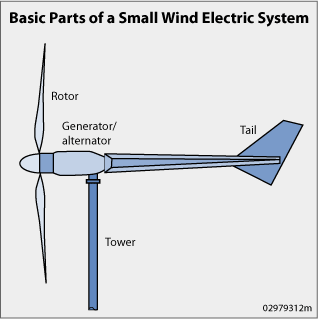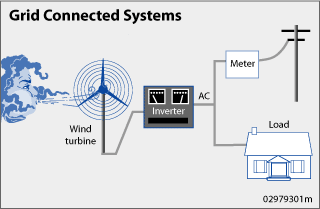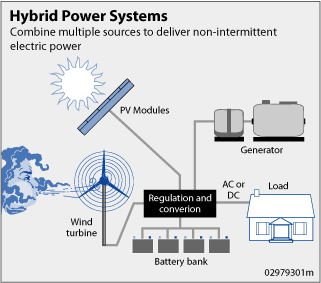Wind
Wind can generate on-site electricity for homeowners. Wind is created by unequal heating of the earth's surface and can be harnessed to directly produce electricity. A wind turbine captures the energy of the wind and converts it into rotary motion that drives a generator to produce electricity.

Much like home PV solar systems, small wind systems can be either off the grid or grid connected. With grid connected wind systems, the homeowner can sell excess electricity to the utility or purchase electricity from the utility if necessary during low wind or no wind conditions.

The ability to use wind systems to produce electricity is more limited than opportunities for solar systems. While solar systems can be used in many U.S. locations, careful study is required to ensure there is adequate wind to allow wind systems to function efficiently. Zoning requirements in residential areas may also limit use of wind power systems.
Hybrid Wind/Solar Systems
There are advantages to considering an on-site electric system that combines wind and solar. This hybrid approach is common for homes that are in off-the-grid, remote locations. By combining wind and solar, the weakness of each approach (lack of wind or sunlight) can be offset. In the United States, wind speeds are often lowest in the summer when the solar energy from the sun is strongest, while wind tends to be stronger in the winter when less sunlight is available. A wind/solar hybrid system offers a more reliable approach to year-round electricity production than either approach alone. Typically, these off-the-grid hybrid systems utilize a battery system to store electricity when household energy demands are low and to supplement the system's output when household needs exceed the electricity being produced.


2 comments:
Here's how to cut your power bill by 75%:
Want to know how to easily produce all of the green energy you could ever want right at home?
And you’ll be able to make your home totally immune from power outages, blackouts, and energy grid outages…
so even if everyone else in your area (or even the whole country) loses power you won’t.
READ MORE: DIY HOME ENERGY
There's a chance you are qualified for a new solar energy program.
Discover if you are eligble now!
Post a Comment